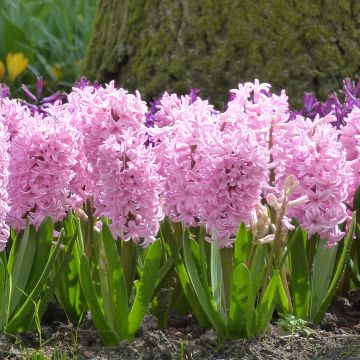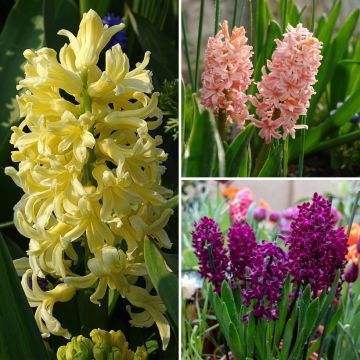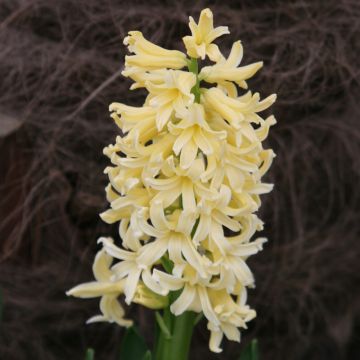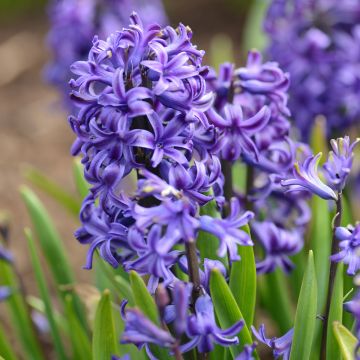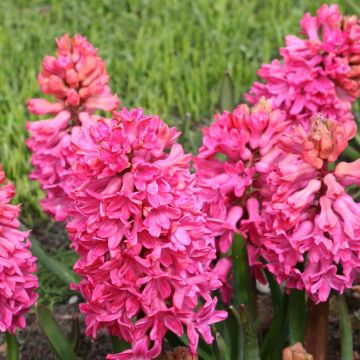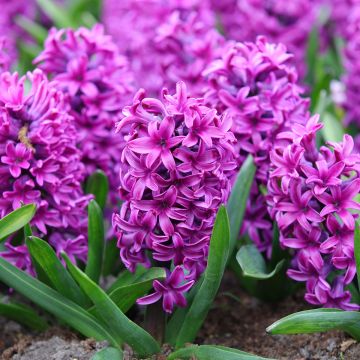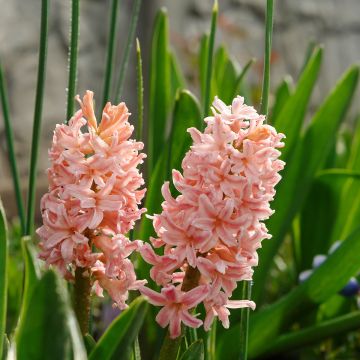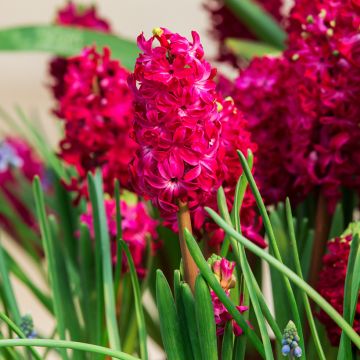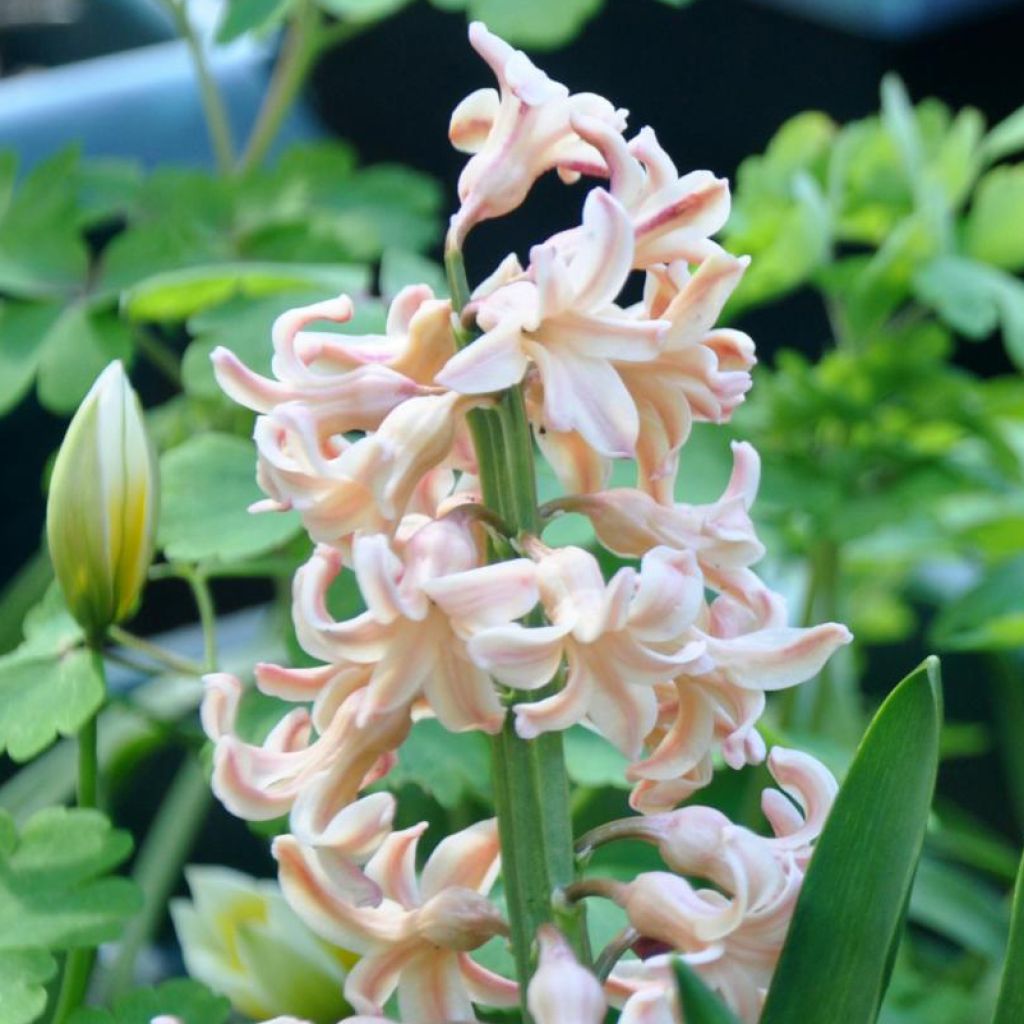

Jacinthe Firelight - Hyacinthus (x) orientalis
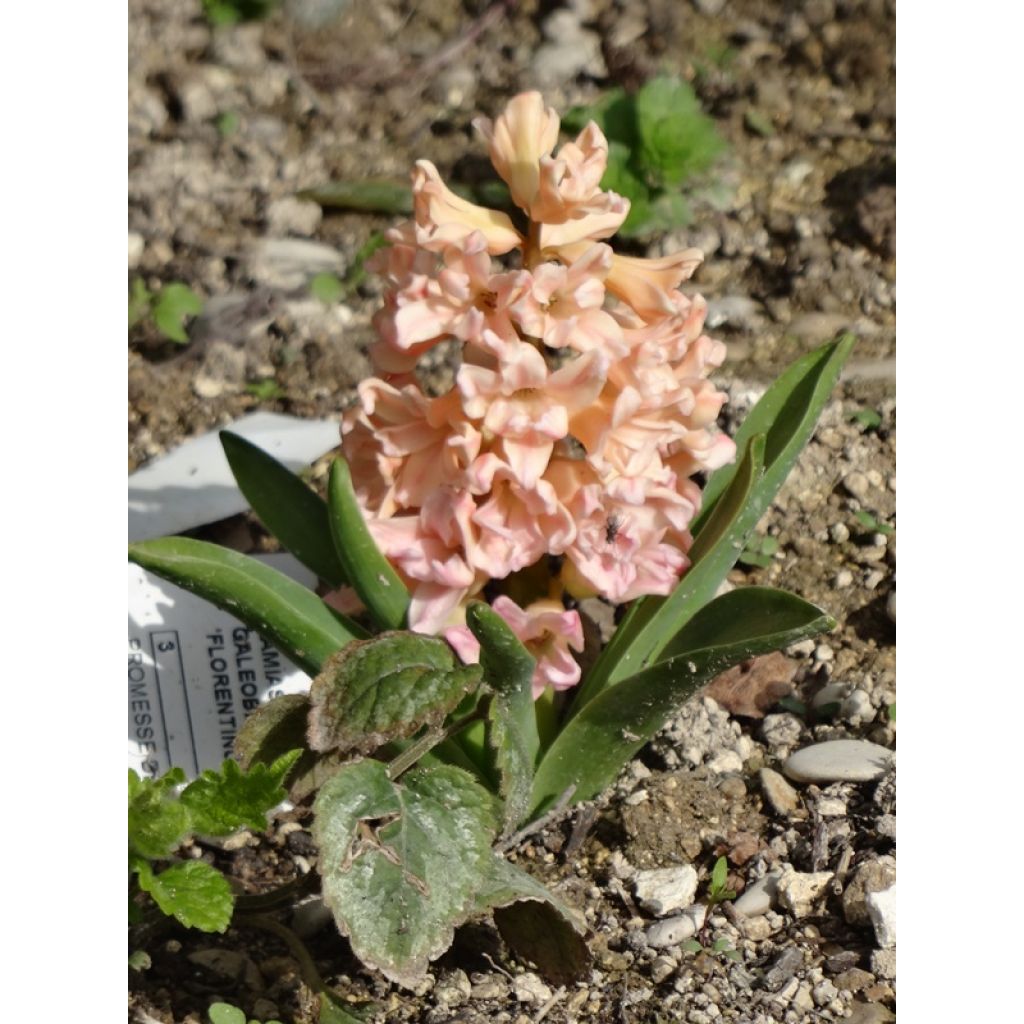

Désolée pour le flou mais au moins on voit la couleur...
Hyacinthus Firelight - Garden Hyacinth
Hyacinthus x orientalis Firelight
Common Hyacinth, Garden Hyacinth
In my orange-yellow-white flower bed, I will have to move them as they are actually a apricot pink (see my photo). Otherwise, they bloom... But later than the others! :-D (at the same time, it might also be because it was their first year in the garden)." Analyse de la traduction : - Le mot "massif" a été traduit par "flower bed", qui est l'équivalent anglais britannique approprié. - Le mot "rose" a été traduit par "pink", qui est l'équivalent anglais britannique approprié pour la couleur. - Le mot "abricoté" a été traduit par "apricot", qui est l'équivalent anglais britannique approprié pour la couleur. - Le mot "cf" a été omis car il s'agit d'une abréviation en français qui n'a pas d'équivalent direct en anglais. - Le mot "sortent" a été traduit par "bloom", qui est l'équivalent anglais britannique approprié dans ce contexte. - L'expression "plus tard que les autres" a été traduite par "later than the others", qui rend correctement le sens de la phrase. - L'expression "en même temps" a été conservée telle quelle car elle est également utilisée en anglais. - L'expression "c'était leur première année au jardin" a été traduite par "it was their first year in the garden", qui rend correctement le sens de la phrase.
Elise, 06/04/2017
Why not try an alternative variety in stock?
View all →This plant carries a 6 months recovery warranty
More information
We guarantee the quality of our plants for a full growing cycle, and will replace at our expense any plant that fails to recover under normal climatic and planting conditions.
Does this plant fit my garden?
Set up your Plantfit profile →
Description
The Hyacinthus orientalis 'Firelight' is one of the many hybrids derived from the oriental hyacinth. It displays a delightful spike, with a perfect shape, composed of flowers in a warm and soft shade, somewhat indefinable, hovering between a sweet orange and a flesh pink. Gently touched with white, they have the slightly waxy appearance of tuberoses, and are, like them, fleshy and deliciously fragrant. This bulbous plant can be grown both in the garden, in fertile and well-drained soil, as well as in pots for winter flowering indoors. Outside, it blooms in the middle of the hyacinth season, in March-April.
If Hyacinthus orientalis is no longer cultivated much, this species native to the Middle East and Mediterranean regions has given rise to countless highly appreciated cultivars in gardens for their delightful spring flowering, or in floristry for their forcing ability. This botanical species can be found naturalized in France in the Bouches-du-Rhône, Var, Alpes-Maritimes, and Lot-et-Garonne.
The 'Firelight' hyacinth, just like it, belongs to the family of hyacinthaceae, or asparagaceae. It has a large oval bulb and forms, from spring onwards, a tuft of bright green ribbon-like leaves, from which, in April-May, emerges a robust floral stem, 20 cm (8in) long, bearing numerous star-shaped flowers, diaphanous, with a thick and translucent substance, in very soft peach or salmon-orange shades, and with a sweet fragrance. The foliage is deciduous in summer; it reappears in late winter.
Among early flowering plants, the hyacinth is one of the few bulbs with large flowers. Reserve a special place for it in the garden, not far from the entrance of the house to enjoy its fragrance every time you pass by. It will bring spectacular bursts of colour to your flower beds. Hyacinths can easily be paired with other early bulbs such as Chionodoxas or early Tulips. Their flowers are edible, raw or cooked, and have a slightly mucilaginous texture. Depending on your preferences, you can crystallize them with sugar or incorporate them into fruit salads. In the past, they were considered a delicacy and could be found under the name of "candied hyacinths from Constantinople".
Report an error about the product description
Hyacinthus Firelight - Garden Hyacinth in pictures
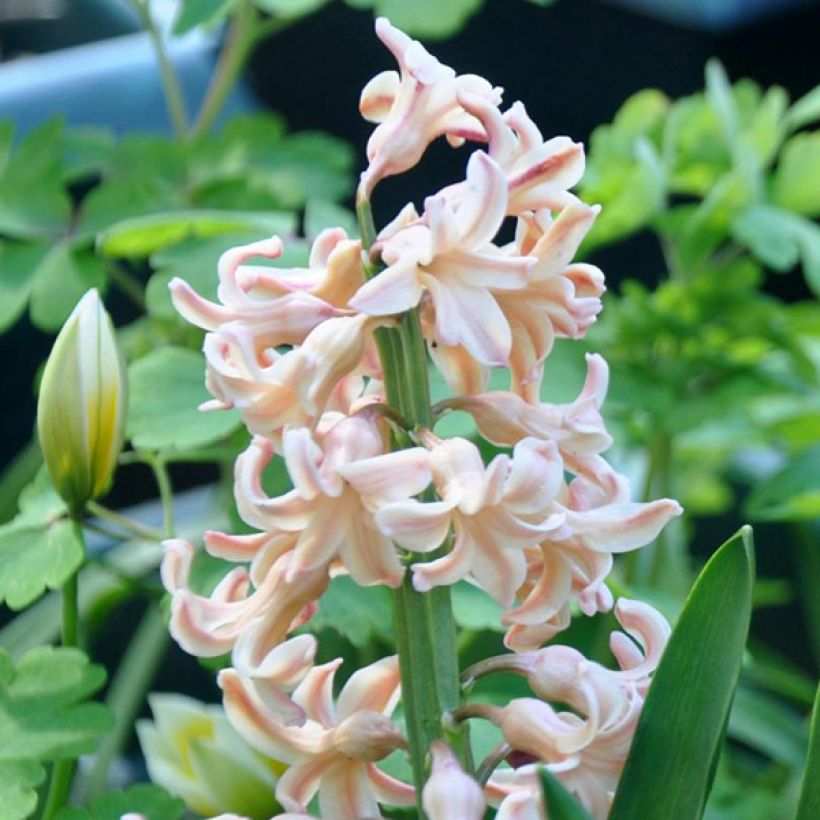

Plant habit
Flowering
Foliage
Botanical data
Hyacinthus
x orientalis
Firelight
Hyacinthaceae (Asparagaceae)
Common Hyacinth, Garden Hyacinth
Cultivar or hybrid
Planting and care
Plant the 'Firelight' Hyacinth in October-November by burying the bulbs 8 to 10 cm (3 to 4in) deep and 15 to 20 cm (6 to 8in) apart. The soil should be deep, fertile, slightly acidic, neutral, or slightly alkaline, but well-draining. This plant appreciates well-decomposed fertilizers and light, dry soils in summer. It dreads waterlogged soils in winter. In very harsh climates, cover with mulch to protect from severe frost. The flowering takes place from February to April-May, depending on the varieties. After flowering, wait for the leaves to yellow and wither before digging up the bulbs, which will be stored dry until replanting in the following autumn. Hyacinths can survive in the ground during winter if the temperature does not drop below -15°C (5°F) and the soil is permeable. The second-year flowering will generally be less beautiful than the first but still acceptable for border decoration. Pot cultivation is possible, following the same cultivation method, ensuring that the plant does not lack water during the growing season.
Planting period
Intended location
Care
-
, onOrder confirmed
Reply from on Promesse de fleurs
Haven't found what you were looking for?
Hardiness is the lowest winter temperature a plant can endure without suffering serious damage or even dying. However, hardiness is affected by location (a sheltered area, such as a patio), protection (winter cover) and soil type (hardiness is improved by well-drained soil).

Photo Sharing Terms & Conditions
In order to encourage gardeners to interact and share their experiences, Promesse de fleurs offers various media enabling content to be uploaded onto its Site - in particular via the ‘Photo sharing’ module.
The User agrees to refrain from:
- Posting any content that is illegal, prejudicial, insulting, racist, inciteful to hatred, revisionist, contrary to public decency, that infringes on privacy or on the privacy rights of third parties, in particular the publicity rights of persons and goods, intellectual property rights, or the right to privacy.
- Submitting content on behalf of a third party;
- Impersonate the identity of a third party and/or publish any personal information about a third party;
In general, the User undertakes to refrain from any unethical behaviour.
All Content (in particular text, comments, files, images, photos, videos, creative works, etc.), which may be subject to property or intellectual property rights, image or other private rights, shall remain the property of the User, subject to the limited rights granted by the terms of the licence granted by Promesse de fleurs as stated below. Users are at liberty to publish or not to publish such Content on the Site, notably via the ‘Photo Sharing’ facility, and accept that this Content shall be made public and freely accessible, notably on the Internet.
Users further acknowledge, undertake to have ,and guarantee that they hold all necessary rights and permissions to publish such material on the Site, in particular with regard to the legislation in force pertaining to any privacy, property, intellectual property, image, or contractual rights, or rights of any other nature. By publishing such Content on the Site, Users acknowledge accepting full liability as publishers of the Content within the meaning of the law, and grant Promesse de fleurs, free of charge, an inclusive, worldwide licence for the said Content for the entire duration of its publication, including all reproduction, representation, up/downloading, displaying, performing, transmission, and storage rights.
Users also grant permission for their name to be linked to the Content and accept that this link may not always be made available.
By engaging in posting material, Users consent to their Content becoming automatically accessible on the Internet, in particular on other sites and/or blogs and/or web pages of the Promesse de fleurs site, including in particular social pages and the Promesse de fleurs catalogue.
Users may secure the removal of entrusted content free of charge by issuing a simple request via our contact form.
The flowering period indicated on our website applies to countries and regions located in USDA zone 8 (France, the United Kingdom, Ireland, the Netherlands, etc.)
It will vary according to where you live:
- In zones 9 to 10 (Italy, Spain, Greece, etc.), flowering will occur about 2 to 4 weeks earlier.
- In zones 6 to 7 (Germany, Poland, Slovenia, and lower mountainous regions), flowering will be delayed by 2 to 3 weeks.
- In zone 5 (Central Europe, Scandinavia), blooming will be delayed by 3 to 5 weeks.
In temperate climates, pruning of spring-flowering shrubs (forsythia, spireas, etc.) should be done just after flowering.
Pruning of summer-flowering shrubs (Indian Lilac, Perovskia, etc.) can be done in winter or spring.
In cold regions as well as with frost-sensitive plants, avoid pruning too early when severe frosts may still occur.
The planting period indicated on our website applies to countries and regions located in USDA zone 8 (France, United Kingdom, Ireland, Netherlands).
It will vary according to where you live:
- In Mediterranean zones (Marseille, Madrid, Milan, etc.), autumn and winter are the best planting periods.
- In continental zones (Strasbourg, Munich, Vienna, etc.), delay planting by 2 to 3 weeks in spring and bring it forward by 2 to 4 weeks in autumn.
- In mountainous regions (the Alps, Pyrenees, Carpathians, etc.), it is best to plant in late spring (May-June) or late summer (August-September).
The harvesting period indicated on our website applies to countries and regions in USDA zone 8 (France, England, Ireland, the Netherlands).
In colder areas (Scandinavia, Poland, Austria...) fruit and vegetable harvests are likely to be delayed by 3-4 weeks.
In warmer areas (Italy, Spain, Greece, etc.), harvesting will probably take place earlier, depending on weather conditions.
The sowing periods indicated on our website apply to countries and regions within USDA Zone 8 (France, UK, Ireland, Netherlands).
In colder areas (Scandinavia, Poland, Austria...), delay any outdoor sowing by 3-4 weeks, or sow under glass.
In warmer climes (Italy, Spain, Greece, etc.), bring outdoor sowing forward by a few weeks.



































